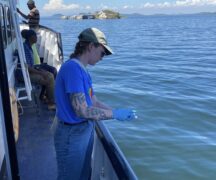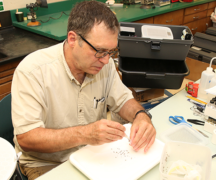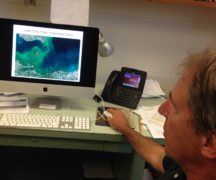By DAVID DUPONT
BG Independent News
Bowling Green State University Monday announced the launch of the Lake Erie Center for Fresh Waters and Human Health.

U.S. Rep. Marcy Kaptur being interviewed by Clint Corpe of WBGU-FM
BGSU will lead the collaboration with nine other universities and research institutions. The project is being funded by a $5.2 million federal grant from the National Institute of Health and the National Science Foundation. The physical hubs for the research will be the University of Toledo’s Lake Erie Center and Ohio State University’s Stone Lab.
BGSU faculty member George Bullerjahn will direct the center and serve as lead researcher.
Bullerjahn said the center is an outgrowth of the collaborations that started after the Toledo Water Crisis of 2014. That event “brought a bunch of scientists together who found they had complementary interests, and they liked each other,” he said. “What this does is it allows a very talented team of diversely trained scientist to work together for a long period of time and with more resources.”
Though the research has been ongoing in many different institutions since the Western Basin of Lake Erie captured national attention, many questions remain.
“One gap we have is we know the water turns green, but we can’t predict how green the water will get or how toxic it may get,” Bullerjahn said.
Researchers will be looking at what causes algal blooms, and what kills them, and the mechanisms that turn them toxic.
“You can look at a body of water that’s quite green, and it may not be toxic at all,” Bullerjahn said. “If you look at the 2014 Toledo Water Crisis, the water was not that green. It was a minor bloom. But it was toxic as hell. How do you sort that out? So that’s one of the things we’re working on. … Can we predict when the bloom forms and when they decline?”
Bullerjahn described himself as “optimistic and patient.”
The problem cannot be solved in a year or two, but “we’ll be in better shape in 10 years,” he said. “I think we’re understanding more and more about the terrestrial issues and what land use practices need to be modified to limit nutrient runoff.”
Other areas of the country are in much worse shape, he said.
“These types of responses are reactionary. Blooms started to occur in mid-‘90s and have gotten worse,” said Tim Davis, another member of the BGSU faculty in biology. The center’s efforts will break down silos, and will have scientists working from a common set of data that will be widely shared, he said. Collegiality is an essential ingredient in the project.
“We’re tying to get the best science possible to put together mitigation practices and strategies that will allow us to develop long term solutions. We want to do this as quickly as possible.”
Still, Davis said, the response of Lake Erie is likely to be delayed. Nutrients like phosphorus and nitrogen will remain in the soil and possibly in sediments in the lake for years.
Global warming will also have an impact.
Global warming directly or indirectly causes more rain, which washes more nutrients from farm fields into the lake. That results in bigger blooms that grow more quickly, and occur earlier in the spring and last well into the fall, Davis said.
U.S. Rep. Marcy Kaptur said she has talked to farmers who tell her this change in weather patterns is overwhelming the tile systems they have in place to drain their fields.
Kaptur, who co-chairs the Great Lakes Task Force in the U.S. House, said getting funding for the region is a challenge. The Great Lakes region tends to be overshadowed by the interests of the East, West, and Gulf coasts.
Even within the state, legislators from other areas are “uneducated” about the challenges facing Lake Erie despite the work of such “champions” as State Sen. Randy Gardner (R-Ohio).
Gardner praised the bipartisan coalition in the state legislature that’s brought attention to the needs of the lake.
“The amount of money to fix what is wrong is staggering,” Kaptur said.
Farmers, who she called “good stewards of the land,” tell her with the change in weather patterns they can’t control the effluent from the fields because it rolls off so fast.
The tile in place to drain the Black Swamp takes the water off at “superhighway speeds,” she said. It needs to be reengineered. “We’ll have to find a way to finance this.”
Thomas Bridgeman of the University of Toledo’s Lake Erie Center, said his team, including Davis, will be looking at advanced monitoring techniques as away of getting more and better quality data.
That includes finding ways to sample sediment at the bottom of the lake “where the water meets the mud.”
The researchers will enlist the help of citizens, such as charter boat operators, to collect many more samples than the researchers are able to gather on their own. These include treated cards on which a few drops of water can be placed and that will provide vital genetic information on whatever toxins are present in the water.
The research “also gets at socio-economics of the problem,” Davis said. “There’s a lot of ways in which these blooms can cryptically impact people’s livelihood that haven’t been well documented.”
Gregory Dick, from the University of Michigan said his work will focus on discovering new toxins.
The blooms contain genetic material for the production of many compounds. Some may be other toxins, but some may have medical value.
Other partners in the center are the National Oceanic and Atmospheric Administration, Ohio Sea Grant, SUNY – College of Environmental Science and Forestry, the University of North Carolina, the University of Tennessee, and Michigan State University.





